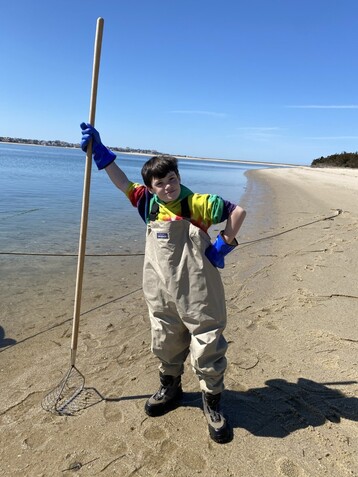Current Waters: Quahogs
Captain Carl Bois •


Bass are still quite prevalent right now. For beach goers, low light will aid in effectiveness. Boat-goers keep in mind that the bass seem to be keyed in on small bait right now, so adjust your presentation accordingly.
Bluefish are eating a lot of small bait as well, but you can always entice an aggressive one with topwater action. Make your life easier and use one single hook on bluefish plugs. It will save time and frustration later.
Fluking is still off to a slow start in-shore. But this is the time of year when things get better every day.
Besides fishing there are many other ways to enjoy Nantucket’s bounty. A fun family adventure can be had heading out to Coatue for some shellfish. Scallop and soft-shell clam seasons are over, but there are other delicacies to be had.
Quahog season is open year-round. These are the rounder shellfish with a hard shell – the kind usually found at clambakes.
A quahog is another name for the hard clam, Mercenaria mercenaria. You may have heard other names for these “hard clams”. A just barely-legal one is often called a “littleneck.” A medium-size quahog is a “cherrystone,” and a big one is often called a “chowder” or simply a quahog. All are delicious and different sizes can be used in different dishes (well, according to my wife anyway).
Quahogs can be found in many places around the island, but the sandy muddy mix in the tidal area is ideal. The sheltered area on the southern shorelines of Coatue are great for quahogging. Madaket harbor has its haunts as well.
Heading to Coatue can be an adventure in itself. To drive there, you need an over-sand vehicle permit. If you have a boat, you can anchor up in the sheltered coves. Alternatively, on a calm day, kayaking over is great fun.
To harvest quahog, they have to be 1 inch from the hinge and each person (with a permit) can harvest a bushel a week. That’s the perfect amount of some chowder or stuffies, but I’m getting ahead of myself.
Quahogs live in the sand between the high tide line and into the water. They tend to congregate along the shorelines, so going at low tide, check the mid to low tide lines. They live close to the surface, so you don’t have to dig too far. Clam rakes are helpful, but not necessary when clamming in the summer. Neoprene gloves sometimes help if you don’t want to scratch up your hands. The only other equipment you need is a basket (a milk crate will do) and a way to measure the quahogs.
Many local tackle shops or Tidal Creek Ship Store can outfit you with a clam rake, float, and basket. With the warm water of summer, however, dig in with feet and then hands and you’ll be fine. It’s a great treasure hunt for kids!
So what to do with your harvest? My favorite has always been “stuffies”. Stuffed quahogs using the bigger ones are delicious. Using the cooked meat removed from the shell, a stuffing made of bread crumbs, onions, spices, and sometimes sausage (or chorizo!) and stuffed back into the cleaned-out shell. Baked in the oven or on the grill these are delicious! You can find lots of recipes for various version of stuffies, chowders, clam cakes, or a good old fashioned boil. For the super fresh version steam them open right on the grill, add a little lemon or melted butter and enjoy!
Town of Nantucket shellfish permits are only $35 for residents, $125 for non-residents or $50 non-resident for a one week pass. And if you’re a resident over 60, it’s free (but you still need to get one). The Town’s website details regulations, has shell fishing guides, and provides insight on where and how to pay and pick up buttons.